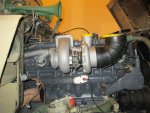Here is some basic diesel info for those coming from the gas world or just not familiar with diesels. They are the opposite of a gas engine in that more fuel = more power and heat. You turn up the fuel to get power, and it will run hotter and smoke more. With a gas engine, more fuel makes it slower. That's called "running rich." Less fuel is "running lean" and that raises power and heat. With a gas engine you HAVE to increase the air flow into the engine to make more power. This usually increases rpm, which usually makes more power by itself, and it allows you to turn up the fuel to match so it doesn't run too hot. That’s expensive in a naturally aspirated engine because you have to change camshafts and maybe go bigger on the valves and port the head. With a diesel just crank up the fuel and maybe injection timing, and if it runs too hot or smokes more than you like, add a turbo. Or replace a small turbo with a bigger one. More air (oxygen) going into a diesel = cooler running.
Nearly all diesels are turbocharged now. The large diesel hydrocarbon molecule has a lot of power within it but when the engine is naturally aspirated, it doesn't suck enough air in to match up well to that molecule. Turbocharging force-feeds air into the cylinder and the oxygen within the air really wakes up the burn. More oxygen allows more fuel duration (a longer squirt) while keeping heat OK.
Anyone wanting to jack up their diesel's power should start with an exhaust gas temperature gauge (pyrometer) with sender probe in the manifold). Know your baseline first. Then as you increase the fuel duration you will see the average temp rise. Experts on these engines will know more about max EGT than me. More power is generally not good when towing heavy because the EGT goes up when your foot is into it more. One way to drive around this is to downshift to raise RPM. That brings in more air, and air cools EGT. Of course doing that decreases road speed, and RPMs may go up too high for the engine design as posters have said.
So to get the jacked up engine working right, more mass air is needed, and that is usually done with a turbo. It is not exactly about high turbo boost pressure. A larger compressor can supply the same mass of air at relatively low pressure as a smaller compressor at high pressure. The main downside to high boost is the air is heated up more. In the performance diesel pickup world where we see over 40 psi boost pressure, we see air temp over 400*F coming out of the compressor. This is why charge-air coolers (misnamed intercoolers) are so important. They cool the boosted air so it’s denser going into the engine. That means more oxygen molecules in a given volume. A CAC is good on any turbocharged engine, especially a diesel. It’s so important on a high boost engine it is usually mounted in front of the radiator. On some vehicles it is below the radiator.
Turbo sizing is complicated and I won’t get much into it except to say if the turbine wheel and housing are on the small side, there is more exhaust back pressure which gets the wheel spinning faster, meaning the shaft and compressor wheel too. That is called “quick spooling” = air out of the compressor faster. But EGT will go up due to that back pressure, and too much boost at the compressor is not good. Some turbos have wastegates that vent the turbine housing to slow the turbine wheel down when a certain max boost in the compressor is reached. This allows fast spooling and more air early, without overspinning the turbo. On the other hand, a large turbine, usually found on a large turbo, tends to offer lower EGT but the big wheel in a large capacity turbine housing is slow to get moving. So it can be “laggy” as engine rpm starts increasing, smoking out the intersection and the engine not making power until the turbo spools up enough so the compressor wheel is pumping some volume.
Most people wanting to put a turbo on a NA engine, or go to a larger turbo, usually get an expert’s advice or they select a turbo that is designed to work on approximately the same engine size and power rating that they want to achieve. For example I know of a turbo that came on a 14L CAT that made 500 hp and if you put a certain smaller turbine housing on it, it turns into the turbo that came on a 600+hp CAT. This is because the wheels spin faster and so there is enough air to match the increased fueling on the higher-rated version of the engine.
I know of several excellent diesel injection companies in the midwest that are also big turbo distributors. They have drive-in service. They are not so much into hot-rodding big trucks but they are a good place to go when you know what original equipment turbo or injector you want. One is big in ractor pull race parts. One does extrude-honing of injector nozzles if you want them larger. I can share the info privately.
Hope this helps.



